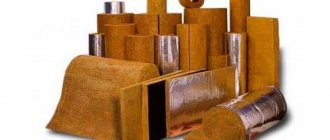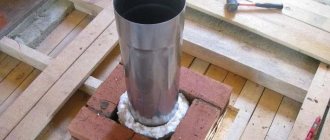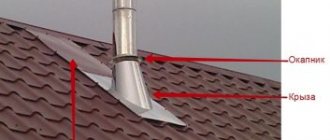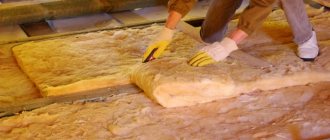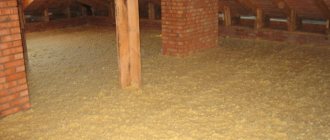Many modern thermal insulation materials have excellent technical characteristics that can fully satisfy the need for insulation and sound insulation. However, not all of them can boast of such quality as fire resistance. Truly non-flammable insulation with the best thermal conductivity is stone mineral wool.
Why insulate
For proper operation of furnaces or boilers, it is necessary that there is good draft in the pipe. This is especially important when using periodically heated stoves. When the chimney is cold, it is very difficult to immediately light a fire in the firebox. This is explained by the fact that cold air tends downward, and warm air tends upward.
If the height of the chimney is large, then it contains a lot of cold air, making it difficult to ignite. If the cross-section of the chimney channel is small, it is recommended to first burn some wood in the firebox, and then, as it warms up, load it with the calculated amount of fuel.
The soot that forms on the walls of chimneys also limits draft. It is formed if the temperature of the gases is not enough to ensure complete combustion of volatile fuel particles. At a low temperature of the chimney walls, condensate containing soot particles, products of incomplete combustion of fuel, is deposited on them.
When soot accumulates in the chimney, it may ignite, especially during subsequent intensive combustion. In this case, the temperature in the pipe can increase many times and metal pipes can simply burn out.
In addition to soot, condensate contains carbonic and sulfuric acids, which are chemically aggressive substances and can destroy pipe walls.
The above problems with the chimney can be avoided if you insulate it from the outside. Then the walls will heat up much faster, and there will be no soot formation during combustion.
If units with internal combustion engines are used in the operation of buildings, for example, gas generators for autonomous power supply, then the exhaust pipes that go outside must also be insulated to prevent the formation of condensation and soot.
Of course, to ensure fire safety, you need to use only non-flammable chimney insulation that is quite effective and durable.
Why do you need non-combustible insulation and what to pay attention to
Fire-resistant thermal insulation is necessary for every home because it is not only able to insulate the building from the effects of low temperatures, but also provides safety to the user. This reduces the chance of an accidental fire to 0%. If previously such insulation materials were new, in 2021 there are hundreds of models on the market that are suitable for household stoves, fireplaces, chimneys, baths, while their efficiency remains at a high level.
Oxygen index
The first selection criterion is the oxygen index. The characteristic indicates the minimum amount of oxygen that is present per unit volume of thermal insulation. In total, there are three types of insulation, which differ in flammability threshold:
- 40%. This category includes composite polymers;
- 31%. Glass wool, basalt wool and other fibrous and cellular thermal insulation;
- 20%. It is worth knowing that such products burn well in air, so their use is unacceptable in fire hazardous areas.
Peculiarities
When choosing a fire-resistant heat-insulating substance, it must have the following parameters:
- Burning with a visible flame is permitted, but must not last longer than 10 seconds. This will prevent the fire from spreading to other areas, which will prevent a large fire from starting.
- When burning, the maximum temperature of the material used should not rise above 50 degrees.
- In addition, it is important that the thermal insulation does not lose half of its volume and mass during combustion.
If all these points are met, then the user can be confident in the selected material, because it will never let him down.
This is interesting: Fire-retardant and non-flammable mastics: types and scope of application
Insulation rules
Depending on the material, chimneys can be:
- brick;
- steel;
- ceramic.
Be sure to insulate with non-flammable material only those areas that come into contact with cold street air.
It is also possible to insulate parts of pipes running in unheated attics.
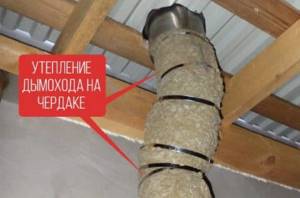
It is not advisable to insulate parts of chimneys passing inside heated rooms, since they are an additional source of heat. An exception is made for metal pipes, which become so hot that you can get burned if you touch them. But even in this case, sometimes it is enough to fence off such areas of the chimneys with mesh screens. Often such solutions are used in village baths.
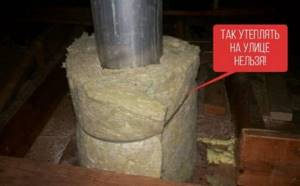
Steel chimneys must be insulated in any case, and the thickness of the layer of non-combustible thermal insulation should be as large as possible. Brick pipes with a wall thickness of brick (25 cm) or more may not be insulated if the air temperature does not drop below -20℃.
Ceramic chimneys are usually made from products that have a honeycomb structure. Such blocks themselves are thermally efficient and do not require insulation.

For thermal insulation, only non-flammable, heat-resistant materials are used, ensuring high fire resistance of the entire building. The value of the fire resistance limit of pipe insulation must not be lower than EI 45.
Advantages of an insulated chimney
An important stage in designing a warm house is organizing thermal insulation of the exhaust duct inside and outside the house. Vapors and soot adhere to the internal surfaces, combine with condensate, and corrode the internal coatings of the channel.
Modern houses are heated by automatic heating systems that switch over and over again, the system heats up and cools down to a certain temperature. With this mode of operation, condensate and combustion waste become several times larger, which leads to rapid destruction of the smoke exhaust channel.
There is only one way out: find out how to carry out proper thermal insulation, which one to buy and apply the insulating base.
Insulating the chimney will reduce heat loss and help:
- provide good ventilation in the duct;
- get rid of freezing;
- reduce the process of settling of resins and vapors on the canal walls;
- will reduce repair costs and heat loss.
Making thermal insulation with your own hands is not difficult, but the main thing is to know how to insulate a metal chimney pipe or brick duct. For use, there are special non-flammable substances used for household and professional thermal insulation.
Why does mineral wool insulation not burn?
Mineral wool is non-flammable when it is stone, made by melting metallurgical waste (blast furnace slag) or basalt rocks. The most fire-resistant stone wool is basalt - this mineral begins to melt at a temperature of about 1000 °C. As a binder in this wool, intended simultaneously for insulation and increasing fire safety, clay and similar compounds are used, which, unlike synthetic adhesives, do not burn. Therefore, basalt mineral wool is non-flammable. Glass mineral wool also belongs to the non-flammable class, because sand really does not burn, it only melts, but its maximum threshold is 450 °C, which is much lower than that of stone fiber.
Application of bricks
One of the old methods of making non-combustible thermal insulation for metal pipes involves the use of broken refractory or clay bricks.
In this case, a steel casing was created around the pipe so that the gap between it and the pipe was about 50-100 mm. The broken brick is poured into this gap. The brick does not need to be compacted and compacted to create thermal gaps. This method of insulation is inexpensive, because it practically does not require special purchase of materials. The disadvantage is the large weight of the entire pipe structure, which negates all other advantages of metal chimneys - quick erection, mobility, the ability to create any configuration.
Liquid fire retardant insulation
These synthetic building materials are characterized by high thermal insulation parameters. Among them there are many modifications that are non-flammable and environmentally friendly. For example, polyurethane. Liquid fillers fill the smallest cracks, completely preventing cold from entering the premises.
Advantages:
- efficiency;
- environmental Safety;
- fire resistance;
- filling density.
Flaws:
- application requires special equipment and skills;
- high price.
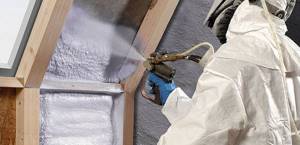
Application of liquid polyurethane
Non-combustible thermal insulation: insulation of brick, asbestos-cement pipes, stainless steel chimneys
The need to insulate high-temperature routes has arisen since their inception. And if the insulation of pipelines was solved quite simply - they were buried in the ground, then the insulation of chimney pipes caused a number of difficulties. And they were associated primarily with the danger of fire of the heat insulator itself. This is why non-flammable thermal insulation for chimneys is a priority when choosing insulation.
The insulation of pipelines was solved quite simply - they were buried in the ground, but the insulation of chimney pipes caused a number of difficulties. And they were associated primarily with the danger of fire of the heat insulator itself. This is why non-flammable thermal insulation for chimneys is a priority when choosing insulation.
For information! In some sources you can read that such a layer is possible without reinforcement, but I would still like to remind you that reinforcement is an element of strengthening, and the layer that you leave will serve as a shield for the pipe, while independently taking on themselves against all temperature fluctuations and aggressive atmospheric influences. Therefore, the stronger the structure, the longer and without problems it will serve.
- Next comes the application of the plaster itself, which must be prepared in two consistencies: pasty and more liquid. Layers are applied one after another, the last being a thick layer, which is leveled and whitened with regular whitewash.
Also suitable for a brick wall are basalt wool mats, foam glass and any other non-flammable thermal insulation material, and the technology will be as follows:
- The pipe is wrapped in insulation: either mats of basalt wool (foam glass) are attached to umbrellas, or a roll is wrapped around the pipe and fixed with wire;
- Next, either prepare another brick box around the pipe, followed by sealing the gap between the main pipe and the casing with cement mortar;
- Either the insulation is wrapped in foil, the lower joining part is cemented to form a cement pad, the joints and seam part are closed with special foil tape.
insulation of brick pipes is as follows:
- At the end of all work, we need to get a layer of 5 cm, this will be quite enough for pipes, so we clean the pipe itself from dirt and unstable layers and reinforce it with a coarse metal mesh;
All the technologies we have described are quite simple, one might say economical, and easy to do with your own hands.
Pipes made of so-called stainless steel
The same materials are used for steel chimneys as for asbestos-cement pipes. Laying technology, materials, fastenings, all this is reminiscent of the previous chapter. Only in this case there are ready-made solutions that you can choose and not suffer. These are the so-called sandwich systems, when the pipe is already in the pipe, and non-combustible insulation is inserted between them.
General recommendations for carrying out work
Warming is a necessary process.
Whatever technologies you choose for insulation, there are general recommendations that, for some reason, are lost in the general cacophony of advice, but which are still worth listening to in order to avoid many embarrassments. So:
- As you have noticed, in all works it is proposed to seal the bottom edge in a cement base, before carrying out such work, make sure that the roof base allows it to be done;
- When carrying out insulation, keep in mind that neither the insulation nor the casing (if any) should come into contact with the roof. That is, it is necessary to think through the docking and drainage system;
- When purchasing adhesive mixtures for fixing the same basalt wool or foam glass, as well as adhesive tape for fixing insulation, pay attention first to the area of application, and then to the price, and not vice versa. The fact is that heat-resistant materials will initially be more expensive than conventional ones;
- When choosing a thermal insulation material, consult the seller about the possibility of using the material. Although the material is imported specifically for your region, sometimes thinner insulation is left behind. Just keep in mind that for insulation work, a material of at least 40 mm is required;
- More complete information may be in the accompanying documents for the material, as well as on the packaging, the official website of the manufacturer, do not be lazy to look at the information.
In what cases is it necessary to use non-combustible insulation?
When building a private house, the owner independently chooses thermal insulation materials based on his capabilities and needs.
Building codes require the use of non-combustible insulation only when constructing the following objects:
- saunas, baths;
- car maintenance and fuel stations;
- underground parking lots, garages;
- premises equipped with stove heating;
- high-rise residential buildings;
- children's and medical institutions;
- buildings that are regularly visited by large numbers of people.
The use of fire-resistant materials is also necessary in rooms where flammable products are stored.
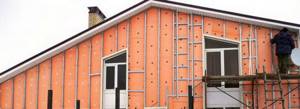
How to make non-flammable thermal insulation of chimneys
When fuel burns in stoves and fireplaces, carbon monoxide is formed. They are removed through the chimney. Despite its apparent simplicity, this design is complex. Chimneys are installed to provide the necessary draft, so they should be correctly brought to the roof, the height determined and connected to the roofing. Properly made thermal insulation for chimneys is also important.
Reasons for insulating chimneys
Furnace gases escaping from the furnace to the outside have a high temperature. When they rush up the chimney channel, condensation forms on its inner walls. This leads to the following problems:
- if moisture is absorbed into the chimney material, it will deteriorate over time;
- sometimes droplets of water settle on the surface of the outlet channels, which reduces their permeability and allows smoke to leak into the room;
- when condensate constantly flows down the walls of the chimney, smudges, hanging drops and an unpleasant odor appear.
Thermal insulation of the chimney helps to avoid these troubles and extends its service life.
Note! The chimney is insulated to prevent rapid cooling. If you do it incorrectly, you can’t count on a positive result.

Methods for insulating furnace ducts
How to isolate the furnace channel depends on the material from which it was made. You can make insulation using:
- crushed bricks;
- slag;
- expanded clay;
- basalt or mineral wool;
- kaolin, etc.
After installing the containment shell, the smoke exhaust structure is lined. For this purpose it is used:
- brick;
- slag concrete and reinforced concrete slabs;
- galvanized metal casings;
- wooden boards;
- profiled sheet, etc.
On a note! The easiest way is to buy a ready-made insulated sandwich pipe and install it at the stage when the chimney is being built.

Let's take a look at some thermal insulation options separately.
Basalt wool insulation
This method of protecting chimneys is attractive due to its accessibility and is therefore used more often than others. Basalt wool has a thickness of 20-100 mm and can withstand temperatures up to 750 degrees. This fire-resistant material is wrapped in several layers around the pipe and secured with wire. A layer of plaster is applied on top.
Lining the chimney with stainless steel sheets is done in the following order:
- measure the perimeter of the pipe, including insulation;
- cut a piece of sheet steel up to one meter long and a width equal to the perimeter of the structure plus an allowance for fastening;
- round the sheet and finish the edges with a roller;
- put the resulting form on the stove chimney, pull it together and fasten it with metal screws;
- In the same way, install several more metal casings on top of each other (make sure that the seams run at an angle of 120˚).
On a note! If you do not use steel casings, the insulation will not last long and you will have to replace it. Even if you insulate the chimney with foil or film, they will not be able to prevent moisture from penetrating into the basalt wool.
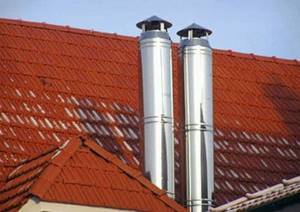
Applications of kaolin
Another method of thermal protection of chimneys is the use of kaolin. The material is characterized as:
Work on installing non-flammable thermal insulation for chimneys is carried out in the following order:
- first plaster the stove channel;
- then glue kaolin sheets to the wet plaster;
- Finally, sew up the chimney with facing material.
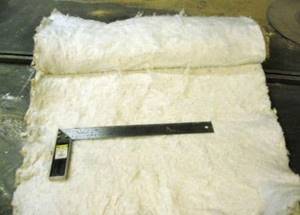
Insulation with mineral wool
Thermal insulation using mineral wool is done as follows.
- Build a metal profile sheathing around the chimney. The profile size is selected depending on the thickness of the insulation, and the lathing pitch depends on the width of the insulating sheets.
- Attach mineral wool to the profile in several layers (do not forget to space the seams).
- Wrap the finished structure with vapor barrier film and seal the joints with tape.
Note! Sheets of metal corrugated sheets can be used as finishing. They are fixed to the sheathing using special screws with rubber gaskets.
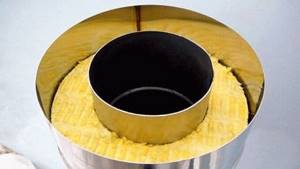
How to insulate a chimney also depends on the material from which it was made.
Chimneys - nuances of insulation
Thermal insulation of steel pipes
The chimney, made of a round steel pipe, is insulated using a ready-made metal case. Large diameter galvanized pipe is suitable for this purpose. The difference in the diameters of the chimney and insulation is 16-20 cm. Thermal insulation is installed in this way.
- Place the casing on the steel chimney.
- Pour expanded clay, broken brick or slag into the space formed between the elements. You can also compact mineral wool, basalt wool or fiberglass between the pipes.
- Fill the open area with cement mortar, waterproof it and install a protective casing on top.
On a note! The profile steel pipe is sheathed using wooden panels or metal sheets (corrugated sheeting). The distance between the components of the structure is 8-10 cm. The space is filled with insulation and securely sealed on top.
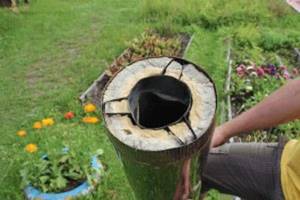
Insulation of brick chimney
In this case, preference is given to mineral wool, which is attached as follows:
- cut out pieces of insulation the size of which corresponds to the area of the side walls of the pipe;
- attach the blanks to the brick using plastic dowels with round heads, or use tape (this option is lightweight, but not reliable);
- cover the attached material with asbestos-cement slabs, corrugated sheets or bricks.
Important! To reduce heat loss, plaster the brick on the outside of the channel, and then cover it with a frost-resistant compound.
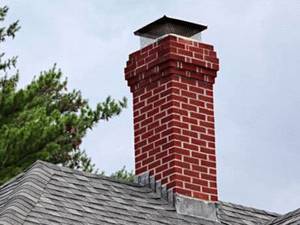
Thermal protection of asbestos-cement pipes
Insulating chimney pipes from asbestos cement is done like this.
- First, clean the outer surface of the chimney from dust and dirt.
- Make a folding metal casing consisting of two halves. When assembled, its diameter should be 12-16 cm larger than the diameter of the pipe. The height of the case can vary within one meter.
- Place the bottom galvanized casing on the chimney.
- Fill or compact protective material into the resulting space.
- Install the next case and reinstall the insulation.
- Cut the top casing together with the asbestos cement pipe at a slight angle.
- Cover the insulation with a thin layer of cement mortar.
On a note! If you do not install a metal case, the mineral wool will become wet, heavy, crumpled or frayed in the wind. Birds, rodents or cats also take away the insulation.
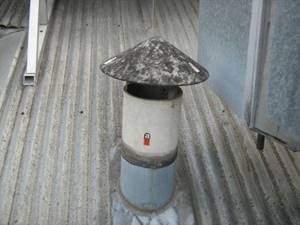
Insulation of the chimney in the ceiling
When a metal chimney passes through a wooden ceiling, the distance between them must be at least 30 cm. If the chimney is lined with brick, then this value is reduced to 10 cm. The opening is filled with basalt wool and closed from below and above with a metal sheet. Make sure that the chimney is securely fastened to the ceiling.
Thermal insulation for chimneys: types of insulation and methods of protecting chimneys, Portal about pipes How to insulate a chimney - non-flammable thermal insulation. What materials are used to insulate chimney pipes in the ceiling? Methods and nuances of insulating structures made of
Do-it-yourself insulation installation
Before starting work, you need to learn the basic rules for applying insulation, and learn how to insulate an iron chimney pipe yourself. Insulation carried out according to the rules will allow the owner not to violate the construction technology and not worry about reducing the draft in the chimney.
Required tools and materials
For installation work on insulating a chimney pipe from the outside, you will need a set of tools that are available in every household: a tape measure, a screwdriver, a grinder, self-tapping screws, metal scissors, a knife for cutting insulation, and protective equipment.
Calculation of the dimensions of the structure
To properly organize the work, you need to calculate the construction parameters and costs. The heating temperature of the inside of the outlet channel, as well as the insulating layer, depend on what type of fuel is used.
The amount of insulation is calculated according to the measurements taken:
- external parameters of the insulated surface;
- height of the structure;
- distance from the lower outlet of the pipe.
For example: on a cold roof and above it, the outlet from a solid fuel heater is wrapped with a layer of 5 cm to 10 cm. The distance on the chimney from the ceiling to the roof in an insulated attic is insulated with a layer of up to 6 cm. The exhaust structure from a gas boiler is insulated with a layer of 3 cm.
The insulation consumption for a chimney for a solid fuel boiler will be, for example, as follows: with its height of 5 m, diameter 219 cm, basalt cylinders need 5 linear meters with a layer thickness of 5 cm, parameters for the internal diameter. Sheet insulation will require 3.5 m². For the protective casing, buy galvanized steel, 2.7 cm thick.
The height of the protruding end depends on the distance of the channel to the roof ridge. Located at a distance of 1.5 m from the center of the house, the chimney should be 50 cm higher than the ridge. Two meters from the center - the height at the level of the ridge, three meters on pitched roofs - the height is determined at an angle of 10°, between the line of the horizon and the ridge.
Work progress
Before installation, you will need to buy chimney sections, anti-corrosion agent, insulation, brackets and clamps, heat-resistant sealant, moisture-proof fabric, galvanized cladding, profiles for the frame, asbestos sealant, fire-resistant foam.
- Before using the insulation, an anti-corrosion substance is applied to the pipe. A protective film is formed on the surface, which protects the metal from destruction for a long time. Combine and secure the parts of the pipe so that moisture does not enter the joints when draining. The connection should be 5-7 cm long for stability.
- After connecting the segments, the metal pipe is wrapped with insulation. The edges of the insulation are wrapped overlapping and secured with steel clamps or aluminum wire. Externally insulated wire cannot be used. Under the influence of high temperatures, the insulation will melt, the fastening strength will weaken, which will lead to deformation of the winding.
- The soft surface is covered with a vapor barrier fabric, and sheets of galvanized steel are fixed on top of it. The galvanizing is fixed with an overlap, from bottom to top, with an overlap of 7-10 cm, fixed with clamps every 30 cm.
- A hole is cut in the roof, which corresponds in diameter to the insulated chimney.
- Under the roof and on the outside of the ceiling to the rafter structure, a horizontal fastening is installed to stabilize the chimney.
- The gaps between the roof and the structure are sealed with heat-resistant non-combustible materials, blown in with heat-resistant foam, and covered with a metal casing.
Basic methods of insulation
We have already discussed the insulation of a metal chimney in particular above. Determine what the casing in the ceiling and on the roof will be made of. Pay special attention to places of insulation near the outlet of the pipe; in those places the greatest temperature difference is observed.
Method of insulating a steel chimney
There is no particular difference between the insulation of a stainless steel channel and the like. Also pay attention to the transition directly in the house, as well as in the insulated part of the roof. Often, many owners are careless about arranging a channel in the attic, but in most cases it is from there that the fire begins to spread. According to the advice of many experts, it is better to completely thermally insulate the channel in an unheated room.
Gas boiler flue insulation
In this case, the same places that were discussed above need to be insulated. You can use the same materials for this as for solid fuel boilers. That is, opt for basalt or asbestos-cement slabs, with a layer of “stainless steel” covered on top.
Whether mineral wool burns or does not burn depends on the binder composition
The basalt mineral wool slab is non-flammable, declared by class (NG) and by the manufacturers. This is completely true if it is made in compliance with technology, from stone fiber and with a natural binder - clay groups and the like (organics).
Mineral wool burns, or more precisely, it is not the mineral fiber itself that burns, but the binder, if it is synthetic (resins, formaldehyde group). Although the melting point of stone fibers is up to 1000 °C, synthetics begin to fade at 250 °C. When used as an organic binder, mineral wool not only does not burn, but also prevents the spread of fire over the surface, which is why it is recognized as non-flammable.
Expert advice
Install a smoke exhaust channel according to the rules. It is also worth taking advice from experts. Thermal insulation is carried out according to the following standards:
- thermal insulation must be applied in a continuous layer, without transitions, especially in places of contact with the ceiling and roof;
- mats and strips are laid only with the markings facing outwards;
- installation of parts is carried out from the bottom up, overlapping, the lower end is covered with the upper connection;
- internal insulation is carried out in stages, during installation of the structure, external insulation after complete assembly;
- a spark arrester is installed at the end if the roof consists of flammable materials;
- use personal protective equipment.
The rules are simple; following them will help prolong the operation of the output channel.


